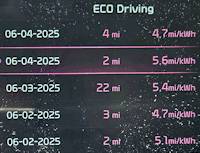Drive by brake Last week, Edmunds reported that a 2025 Dodge Charger EV they’ve been testing began an unintended acceleration. This week Dodge produced an answer: drive by brake, which it turns out is a feature. Well this needed some digging. We’ve examined the car’s manual during our recent symbols update and had come across …
Author's posts
Permanent link to this article: https://dashboardsymbols.com/2025/06/drive-by-brake-what/
The two forms of auto brake hold
Brake hold We’ve now experienced two very different forms of Auto Brake Hold, and only recently adjusted the page to reflect it, 20 different images not withstanding. In any case, some manufacturers have the system active at all times. If the car is started, brake hold is ready to use by default. This was the …
Permanent link to this article: https://dashboardsymbols.com/2025/06/the-two-forms-of-auto-brake-hold/
The Niro is a summertime EV efficiency champ
EV efficiency EV efficiency, measured in miles per kWh (m/kWh), comes up short in the vast majority of electric vehicles. Most will see between three and four m/kWh, covered in some detail here. And the larger the electric vehicle, the lower the efficiency. The Kia Niro I am now driving, however, is a summertime efficiency …
Permanent link to this article: https://dashboardsymbols.com/2025/06/the-niro-is-a-summertime-ev-efficiency-champ/
Misunderstanding regenerative “brakes”
Regenerative “brakes” In researching common questions about regenerative “brakes”, it became clear that there are serious misconceptions about the topic, all of which surround the use of the word brakes or braking. Here are some all too common questions: How much longer do regenerative brakes last? Can regenerative brakes overheat? Does regenerative braking wear out …
Permanent link to this article: https://dashboardsymbols.com/2025/06/misunderstanding-regenerative-brakes/
How much energy does regenerative braking recover?
Regenerative braking So just how much energy does regenerative braking recover? Well, there’s quite a bit of information floating around about the topic out there, and most of it is highly subjective. That said, the best answer is “up to 20%” of an electric vehicle’s (EV) range. So, as a best case scenario, an EV …
Permanent link to this article: https://dashboardsymbols.com/2025/06/how-much-energy-does-regenerative-braking-recover/
Regenerative braking returns to brake rotor issues
Regenerative braking I decided I wanted to answer some common questions about regenerative braking and did some Google searches. AI gave the first response (a technology, by the way, that really hurts my business), and turned up some surprises. The largest of these is yet another reference to problems with the regular, or friction, brakes. …
Permanent link to this article: https://dashboardsymbols.com/2025/06/regenerative-braking-returns-to-brake-rotor-issues/
NHTSA piles on the recalls
Recalls I missed three days of tracking traffic on X and getting caught up wound up reposting a full 24 recalls from the National Highway Traffic Safety Administration (NHTSA). Today found another six, including another air bag recall, this time from Mazda. What initially got our attention were three back-up camera recalls. These devices have …
Permanent link to this article: https://dashboardsymbols.com/2025/06/nhtsa-pile-on-the-recalls/



Marc Favreau
The author has 30+ years of automotive experience and has assembled the most extensive collection of symbols and warning lights anywhere (over 1,000!) and can help you open and start any keyless start car with a dead key fob battery. BA, St. Joseph's, ME: MS, RPI, NY
Most commented posts